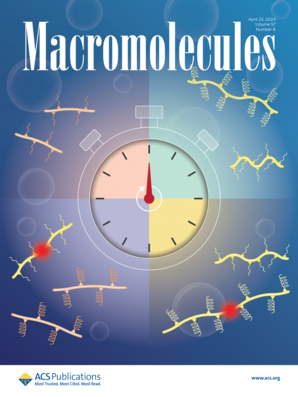Red Sea Star-Inspired, Rapid Underwater Self-Healing Polyurethane Based on Dual Hydrophobic Units and Tandem Dynamic Bonds
IF 5.1
1区 化学
Q1 POLYMER SCIENCE
引用次数: 0
Abstract
Red sea stars exhibit an extraordinary underwater self-healing capability driven by fibrinolytic enzyme secretion, enabling survival in challenging marine environments. Inspired by this biological mechanism, we developed a polyurethane (DSFPU-3) capable of rapid underwater self-healing. By integrating dual hydrophobic units (alkyl side chains and fluorine groups) with tandem dynamic bonds (disulfide and imine bonds), DSFPU-3 achieved a water contact angle of 99.3° and maintained stable microphase structures and micromorphology even after 4-day water soaking. The synergistic effect of hydrophobic units and dynamic bonds enabled self-healing at a speed exceeding 33.33 μm/h, achieving 98% efficiency and allowing the material to endure significant mechanical stress post-healing. Small-molecule modeling experiments and rheological analyses validated the bond exchange mechanisms of the tandem dynamic bonds, underscoring their critical role in accelerating the self-healing process. This study presents a novel strategy for fabricating rapid underwater self-healing polyurethanes, representing a significant advancement in their application under aquatic conditions.

受红海之星启发,基于双疏水单元和串联动态键的快速水下自修复聚氨酯
红海海星在纤维蛋白溶解酶分泌的驱动下表现出非凡的水下自愈能力,使其能够在充满挑战的海洋环境中生存。受这种生物机制的启发,我们开发了一种能够在水下快速自愈的聚氨酯(DSFPU-3)。DSFPU-3通过将双疏水单元(烷基侧链和氟基)与串联动态键(二硫键和亚胺键)结合,实现了99.3°的水接触角,即使在4天的水浸泡后也保持了稳定的微相结构和微形貌。疏水单元和动态键的协同作用使材料的自愈速度超过33.33 μm/h,达到98%的效率,并允许材料在愈合后承受显著的机械应力。小分子模型实验和流变学分析验证了串联动态键的键交换机制,强调了它们在加速自愈过程中的关键作用。本研究提出了一种制造快速水下自愈聚氨酯的新策略,代表了其在水生条件下应用的重大进展。
本文章由计算机程序翻译,如有差异,请以英文原文为准。
求助全文
约1分钟内获得全文
求助全文
来源期刊

Macromolecules
工程技术-高分子科学
CiteScore
9.30
自引率
16.40%
发文量
942
审稿时长
2 months
期刊介绍:
Macromolecules publishes original, fundamental, and impactful research on all aspects of polymer science. Topics of interest include synthesis (e.g., controlled polymerizations, polymerization catalysis, post polymerization modification, new monomer structures and polymer architectures, and polymerization mechanisms/kinetics analysis); phase behavior, thermodynamics, dynamic, and ordering/disordering phenomena (e.g., self-assembly, gelation, crystallization, solution/melt/solid-state characteristics); structure and properties (e.g., mechanical and rheological properties, surface/interfacial characteristics, electronic and transport properties); new state of the art characterization (e.g., spectroscopy, scattering, microscopy, rheology), simulation (e.g., Monte Carlo, molecular dynamics, multi-scale/coarse-grained modeling), and theoretical methods. Renewable/sustainable polymers, polymer networks, responsive polymers, electro-, magneto- and opto-active macromolecules, inorganic polymers, charge-transporting polymers (ion-containing, semiconducting, and conducting), nanostructured polymers, and polymer composites are also of interest. Typical papers published in Macromolecules showcase important and innovative concepts, experimental methods/observations, and theoretical/computational approaches that demonstrate a fundamental advance in the understanding of polymers.
 求助内容:
求助内容: 应助结果提醒方式:
应助结果提醒方式:


